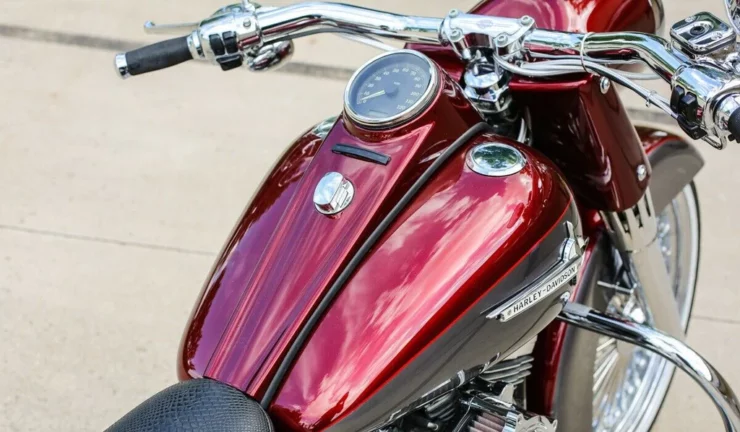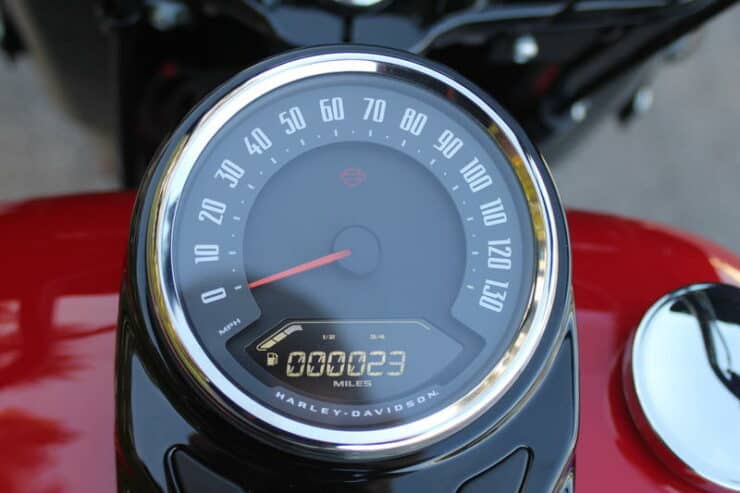If you’ve ever been out for a ride on your Harley Davidson Softail and noticed the gas gauge not working correctly, you know how inconvenient that can be. Don’t let this issue get you down – with just a few simple steps, you can fix the gas gauge on your Softail in no time.
To fix a faulty gas gauge, inspect the wiring connections and fuel sending unit for any issues. Replace the sending unit if necessary or consult a technician for electrical diagnostics if the gauge itself is faulty.
Read on to find out how!
Overview of gas gauges on a Harley
The gas gauge is an important component for any motorcycle, including the Harley-Davidson Softail series. It offers crucial information about the fuel level, allowing the biker to monitor their remaining fuel and plan to refuel accordingly.
Definition of a gas gauge
A gas gauge or also known as a fuel gauge or fuel level indicator is a device that offers a visual representation of the amount of fuel remaining in the bike’s fuel tank. It offers convenience and helps the rider avoid running out of fuel unexpectedly. Gas gauges typically consist of a gauge, a sender unit in the fuel tank, and a connecting electrical circuit.
Types of gas gauges
A Harley-Davidson Softail might have different types of gas gauges, depending on the specific model and year of the bike. Here are the common types of gas gauges that you might encounter for your Softail –
#1. Analog gauge
Analog gas gauges are the traditional type of gauges that use a needle for indicating the fuel level on a circular or semi-circular scale. In a Softail, the analog gas gauge is often integrated into the instrument cluster alongside other indicators like the speedometer and tachometer. The needle moves across the scale, indicating the fuel level as “Empty” to “Full” or using various increments.
#2. Digital gauge
Some newer Softail models might feature a digital gas gauge. Digital gauges make use of an electronic display to present fuel level information. The display can show the fuel level as a numerical value or a series of bars or segments. Digital gauges might also include additional features such as distance-to-empty calculations or low fuel warning indicators.
#3. Low fuel warning light
In addition to or instead of a gas gauge, some Harley-Davidson Softail models might have a low fuel warning light. This warning light is designed to alert bikers when the fuel level reaches a predetermined threshold, indicating that it is time to refuel. When the fuel level drops below a certain point, the light will illuminate, reminding the bikers to find a gas station promptly.
It is important to remember that while gas gauges are particularly useful tools, they aren’t infallible and can be affected by different factors such as inclines, accelerations, and motorcycle tilt. For ensuring accurate readings and avoid running out of fuel, it is always recommended that you monitor the fuel level regularly, make use of trip meters or odometers for estimating the remaining range, and develop a habit of refueling when needed.

Common symptoms of a faulty gas gauge
The gas gauge in your Harley-Davidson Softail is an important component that gives you crucial info about your fuel level. If the gas gauge malfunctions or becomes faulty, it can result in various issues. Recognizing the symptoms of a faulty gas gauge is important to take prompt action and ensure a reliable and accurate fuel level monitoring system. Here are some of the common symptoms that indicate a faulty gas gauge in a Harley-Davidson Softail –
#1. Inconsistent or fluctuating readings
One of the most common signs of a faulty gas gauge is inconsistent or fluctuating readings. You might notice that the gauge needle moves erratically or jumps between different fuel levels even when the tank is full or nearly empty. Inaccurate readings can make it quite difficult to gauge how much fuel is remaining and might result in running out of fuel unexpectedly.
#2. Stuck or non-responsive gauge needle
A stuck or non-responsive gauge needle is another symptom of a faulty gas gauge. The needle might remain in one position, fail to move when you add or consume fuel, or get stuck at a particular fuel level. This can result in confusion and make it challenging to determine the actual amount of fuel in the tank.
#3. Complete gauge failure
In certain cases, the gas gauge might fail entirely, resulting in no reading or response from the gauge. The gauge might remain blank or show no signs of power when the ignition is on. This can be a particularly frustrating situation as you don’t have any indication of your fuel level and will have to rely on other methods to estimate your remaining fuel.
#4. Warning lights or error messages
A faulty gas gauge might trigger warning lights or error messages on your bike’s instrument panel. These warnings could vary depending on the model but might include a low fuel warning light or a specific message indicating a gas gauge malfunction. Pay close attention to these indicators as they can help you identify the problem and take appropriate actions.
#5. Fuel-related problems
Inaccurate gas gauge readings can result in various fuel-related problems. You might find yourself unexpectedly running out of fuel, experiencing engine sputtering or stalling, or having issues starting your bike due to insufficient fuel. These issues can be quite frustrating and potentially dangerous, especially when riding in remote areas or unfamiliar locations.
If you notice any of these issues, it’ll be important that you take immediate actions to diagnose and rectify the problem with your gas gauge. Here are some of the recommended steps that you need to follow –
- Carry out a visual inspection by checking for any visible damage, corrosion, or loose connections on the gas gauge and associated wiring
- Verify the electrical connections by ensuring all electrical connections are secure and free from any corrosion
- Tighten the connections and clean out any corrosion using the appropriate electrical contact cleaner
- Check the fuel level sensor and inspect the fuel level sensor or sender unit in the fuel tank for any damage or misalignment
Lastly, you need to consult a professional if in need. If you aren’t able to identify the issue or resolve it on your own, it is recommended that you should seek assistance from a Harley-Davidson dealership or qualified technician. They have the expertise and specialized tools needed for diagnosing and repairing gas gauge issues accurately.
Maintaining a reliable and accurate gas gauge in your Softail is important for a smooth and worry-free riding experience. By recognizing the common symptoms of a faulty gas gauge and taking appropriate measures, you’ll be able to ensure that you’ve got accurate fuel level readings and avoid potential fuel-related problems on your journeys.

How to diagnose a problem with a gas gauge in a Harley-Davidson Softail
A faulty gas gauge in your Harley-Davidson Softail can result in inaccurate fuel level readings, which makes it quite challenging to plan your rides and potentially leaving you stranded with an empty tank. Fortunately, there are numerous diagnostic steps that you can take to identify and address the issue. Here, you will get to know some of the effective methods to diagnose a faulty gas gauge in a Harley-Davidson Softail.
Visual inspection
Start off the diagnostic process by conducting a thorough visual inspection of the gas gauge and related components. Look out for any obvious signs of damage, corrosion, or loose connections. You must check the gauge face or digital display for cracks or physical defects that might affect its functionalities.
Inspect the wiring leading to and from the gauge, ensuring that there are no frayed wires, loose connections, or signs of wear. Moreover, examine the fuel level sensor or sender unit inside the fuel tank for visible issues, such as damage or misalignment.
Voltage testing
Voltage testing will be an important step to determine if the gas gauge is getting proper electrical power. To do that, you need to follow these steps for performing a voltage test –
- Consult your Harley-Davidson Softail’s service manual to identify the specific wires or terminals that correspond to the gas gauge
- Make use of a multimeter set to the appropriate voltage range to measure the voltage at the gauge connections
- Once the ignition is on and the gauge is connected, you should touch the multimeter problems to the gauge’s positive and negative terminals or wires
- The multimeter must display the expected voltage for the gas gauge
- If the reading is significantly higher or lower than expected, it might indicate a problem with the gauge or the electrical system
Check the loose connections
Loose or faulty connections can result in erratic readings or a complete failure of the gas gauge. You need to perform certain steps to check for loose connections.
- Make sure that the battery terminals are fastened securely and free from corrosion
- Loose or corroded battery connections could affect the gauge’s electrical power
- Inspect all wiring connections associated with the gas gauge, including the sender unit, wiring harness, and gauge itself
- You must tighten any loose connections or replace damaged connectors
- Pay attention to the grounding connections, as poor grounding could result in electrical issues and affect gauge performance
If you have performed these diagnostic steps and still haven’t identified the cause of the faulty gas gauge, it is recommended that you should look for professional assistance from a dealership or qualified technician. They will help you not only find the problem but also diagnose it so that you can drive your bike without any issues.
How to fix gas gauge on Harley-Davidson Softail
A faulty gas gauge in your Harley-Davidson Softail can be frustrating and inconvenient, making it quite challenging to accurately monitor your fuel level. Fortunately, there are numerous repair options available to address the issue and restore proper functioning to your gas gauge. Here are some of the different methods that you should carry out to fix the gas gauge on your Harley-Davidson Softail.
#1. Replace the fuel sending unit
The fuel sending unit is widely responsible for measuring the fuel level in your bike’s tank and transmitting that info to the gas gauge. If the sending unit becomes faulty, it can result in inaccurate readings or a complete failure of the gas gauge. Here are the steps that you need to follow to replace the fuel sending unit –
- Consult your Harley-Davidson Softail’s service manual to locate the fuel sending unit and understand the necessary steps for replacement
- Disconnect the negative terminal of the battery for preventing any electrical accidents
- Drain the fuel tank to a safe level and remove it from your Softail according to the manufacturer’s instructions
- Locate the fuel sending unit and disconnect the wiring and fuel lines attached to it
- Remove the securing screws or clamps holding the sending unit in place and remove the old unit carefully
- Install the new fuel sending unit in the reverse order, ensuring proper alignment and secure attachment
- Then, you should reconnect the wiring and fuel lines and reassemble the fuel tank onto the Softail
- Lastly, reconnect the battery and test the gas gauge for ensuring proper functionality
#2. Replace the float arm
The float arm is an important part of the fuel sending unit that helps in measuring the fuel level by floating on the surface of the fuel in the tank. If the float arm becomes stuck or damaged, it could result in inaccurate readings or gauge malfunctions. Here is how you can replace the float arm –
- First, you must consult your bike’s service manual to locate the float arm within the fuel sending unit and understand the necessary steps for replacement
- Disconnect the negative terminal of the battery for safety
- Remove the fuel sending unit from your Softail following the instructions mentioned earlier
- Carefully detach the float arm from sending unit, ensuring that you do not damage any surrounding components
- Install the new float arm, aligning it properly and securing it in place
- Reassemble the fuel sending unit onto the bike before reconnecting the wiring and fuel lines and reattaching the fuel tank
- Reconnect the battery and test the gas gauge to ensure accurate readings
#3. Replace faulty wiring
Faulty wiring can result in issues with the gas gauge, resulting in inaccurate readings or a complete gauge failure. Here is how to replace faulty wiring –
- Inspect all wiring associated with the gas gauge, including the wiring harness, connectors, and any exposed wiring
- Identify any frayed, damaged, or corroded wiring
- Cut out the damaged section of the wiring and remove the ends of the remaining wire
- Connect and solder new wiring to the stripped ends while making sure there is a secure and reliable connection
- Make use of electrical tape or heat shrink tubing to insulate the spliced area
- Reconnect the wiring, ensuring all connections are secure and properly insulated
- Lastly, test the gas gauge to make sure it is functioning correctly

Preventative maintenance for gas gauges on a Harley-Davidson Softail
One of the best ways of diagnosing any faults in gas gauges in a Harley-Davidson Softail would be to prevent the problem in the first place. Preventing issues through maintenance will help you make things easier. To prevent unexpected issues with your gas gauge and maintain its reliable performance, it will be important to incorporate regular preventive maintenance into your routine. Here are some of the key preventing maintenance steps that you need to follow to maintain the gas gauge and prevent any problems from arising in the first place.
#1. Carry out visual inspections on a regular basis
Performing regular visual inspections of your gas gauge and its associated components will help you identify any signs of potential issues before they escalate. Here are the steps that you need to do –
- Examine the gauge face or digital display for any scratches, cracks, or physical detects that might affect its visibility or functionality
- Check the gauge housing for potential signs of damage or corrosion as corrosion can greatly weaken connections and impair the electrical circuit
- Inspect the wiring leading to and from the gas gauge for any signs of wear, fraying, or loose connections
- Make sure you’re paying close attention to the wiring harness, connectors, and exposed wiring
- Verify that the fuel level sensor or sender unit inside the fuel tank is intact and aligned properly
- Be on the lookout for any physical damage or misalignment that might impact its performance
Regular visual inspections need to be conducted during your routine maintenance checks or whenever you notice any unusual behavior or readings from the gas gauge.
#2. Checking voltage
Checking the voltage supply to the gas gauge will ensure that it is receiving the necessary electrical power for accurate readings. Here are the steps to follow for checking voltage –
- Find out the specific wires or terminals corresponding to the gas gauge
- Connect the multimeter problems to the gauge’s positive and negative terminals or wires
- The multimeter must display the expected voltage for the gas gauge
- Make sure that the reading falls within the appropriate range
- If it doesn’t, you will need to troubleshoot the issue with the gauge or the electrical system
Checking the voltage periodically, especially during routine maintenance will help in identifying any potential electrical problems that might affect the gas gauge’s performance.
#3. Keeping the connections tight
Maintaining tight and secure connections will be important for the proper functioning of your gas gauge. Over time, vibrations and regular use can loosen connections, resulting in erratic readings or gauge failure. Here are the steps that you need to follow –
- Regularly inspect all wiring connections associated with the gas gauge, including the wiring harness, sender unit, and the gas gauge itself
- Check that all the connections are properly seated and tightened
- Make sure that the wiring connectors are clean and secure
- If you encounter any loose connections, you must tighten them using the appropriate tools
- Avoid overtightening as it might damage the connectors or wiring
- Make sure that you use electrical tape to insulate and protect the connections from moisture and damage
By keeping connections tight and secure, you will be able to reduce the risk of intermittent electrical problems that might affect the gas gauge’s accuracy and reliability.
Incorporating these maintenance steps into your regular servicing and routine will help ensure the longevity and accuracy of the gas gauge in your Harley-Davidson Softail. Regular maintenance will allow you to enjoy worry-free rides with accurate fuel level readings. Remember, if you encounter any complex issues or you are unsure about performing maintenance tasks, you should not hesitate in consulting a professional technician for help.
Also read: How to Replace Fuel Injectors on Harley-Davidson
FAQs
What could be causing my Harley Davidson Softail’s gas gauge to malfunction?
There are several potential causes of a gas gauge malfunction on a Harley Davidson Softail, including a faulty sending unit, a damaged wiring harness, or a faulty circuit board. It is important to diagnose the issue to determine the exact cause of the malfunction.
What steps should I take to fix my Harley Davidson Softail’s gas gauge?
In order to fix a gas gauge on a Harley Davidson Softail, you should first determine the cause of the problem. If the sending unit is the cause, replace it with a new one. If the wiring harness or circuit board is the cause, replace them with new components. In some cases, you may need to adjust the fuel level sensor to ensure the gauge is calibrated correctly.
What should I do if I’m unable to fix my Harley Davidson Softail’s gas gauge?
If you are unable to fix the gas gauge on your Harley Davidson Softail, you should contact a professional mechanic for assistance. A qualified mechanic will be able to diagnose the issue and provide the necessary repairs to ensure your gas gauge is functioning properly.


Great video
My 2013 Slim with 2,000 miles turns over great but won’t fire up – Gas pump light flashes and gauge stays on empty- any ideas?
Hi Bill,
Thanks for your comment and I’m glad you found the video helpful!
Based on what you’ve described, it sounds like your Harley-Davidson Softail Slim might be experiencing an issue with its fuel system. The gas pump light flashing and the gauge staying on empty could indicate a problem with the fuel pump or the fuel level sensor.
Here are a few steps you can take to troubleshoot the issue:
1. Check the Fuse: First, make sure the fuse for the fuel pump is intact. A blown fuse could prevent the fuel pump from operating.
2. Inspect the Fuel Pump: If the fuse is okay, the issue might be with the fuel pump itself. Listen for a humming or whirring sound from the fuel pump when you turn the ignition to the ON position. If you don’t hear anything, the fuel pump might not be functioning properly.
3. Fuel Level Sensor: The problem could also be with the fuel level sensor, which might be giving incorrect readings. This sensor is typically located in the fuel tank and might require professional diagnosis and replacement.
4. Battery Voltage: Ensure your battery is fully charged. Low battery voltage can sometimes cause issues with starting and with the proper functioning of electrical components.
If you’re not comfortable performing these checks yourself, or if the problem persists, I highly recommend taking your Softail to a certified Harley-Davidson mechanic. They can provide a comprehensive diagnosis and resolve the issue so you can get back to enjoying your ride.
Remember, dealing with fuel systems can be complex and sometimes dangerous if not handled correctly, so don’t hesitate to seek professional help if needed.
Ride safe!